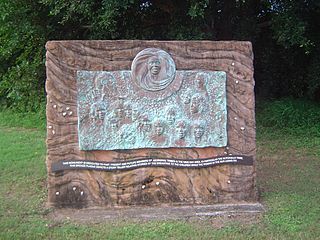
The Gubbi Gubbi people also known as Kabi Kabi are an Aboriginal Australian people native to south-eastern Queensland. They are now classified as one of several Murri language groups in Queensland.

Norman Barnett Tindale AO was an Australian anthropologist, archaeologist, entomologist and ethnologist.

The Dharawal people, also spelt Tharawal and other variants, are an Aboriginal Australian people, identified by the Dharawal language. Traditionally, they lived as hunter–fisher–gatherers in family groups or clans with ties of kinship, scattered along the coastal area of what is now the Sydney basin in New South Wales.
Kabi Kabi, also spelt Gabi-Gabi/Gubbi Gubbi, is a language of Queensland in Australia, formerly spoken by the Kabi Kabi people of South-east Queensland. The main dialect, Kabi Kabi, is extinct, but there are still 24 people with knowledge of the Butchulla dialect, a language spoken by the Butchulla people of K'gari.
The Pangerang, also spelt Bangerang and Bangarang, are the Indigenous Australians who traditionally occupied much of what is now north-eastern Victoria stretching along the Murray River to Echuca and into the areas of the southern Riverina in New South Wales. They may not have been an independent tribal reality, as Norman Tindale thought, but one of the many Yorta Yorta tribes. For the purposes of this article, they are treated separately, according to those sources that maintain the distinction.
The Djiru, otherwise spelt Jirru, Are an Aboriginal Australian people whose traditional lands are along the coasts of Northern Queensland, mainly the area around Mission Beach.
The Djindubari, also written Jindoobarrie or Joondubarri, are or were an Aboriginal Australian people of southern Queensland, whose traditional lands were located on Bribie Island. They are thought to be a horde or clan of the Undanbi.

The Butchulla, also written Butchella, Badjala, Badjula, Badjela, Bajellah, Badtjala and Budjilla are an Aboriginal Australian people of K'gari, Queensland, and a small area of the nearby mainland of southern Queensland.
The Barungguan are an Aboriginal Australian people of the Cape York Peninsula of Northern Queensland. The name is associated with three languages: Ganganda, Umpithamu and Morrobolam.
The Undanbi are an Aboriginal Australian people of southern Queensland. Alternative or clan names include Inabara, Djindubari and Ningy Ningy.
The Mutumui were an indigenous Australian people of northern Queensland.
The Walmbaria are an indigenous Australian people of Cape York Peninsula in northern Queensland.
The Kwiambal are an Aboriginal Australian people of New South Wales.
The Wanggumara, also spelt Wangkumara, Wongkumara, Wangkumarra, and other variants, are an Aboriginal people of the state of Queensland, Australia.
The Warrgamay people, also spelt Warakamai, are an Aboriginal Australian people of the state of Queensland.
The Kuku Buyunji (Kokobujundji), alternatively known as the Kuku Nyungkal or Annan River tribe are an indigenous Australian people of the state of Queensland.
The Julaolinja were an indigenous Australian people of the state of Queensland.
The Wakaman people, also spelt Wagaman, are an Aboriginal Australian people of the state of Queensland. According to some authorities, they may be interchangeable with the group identified by ethnographers as the Agwamin.
The Yagalingu are an Aboriginal Australian people of the state of Queensland. Their language may have been a dialect of Bidjara.
The Mitaka were an indigenous Australian people of the state of Queensland.